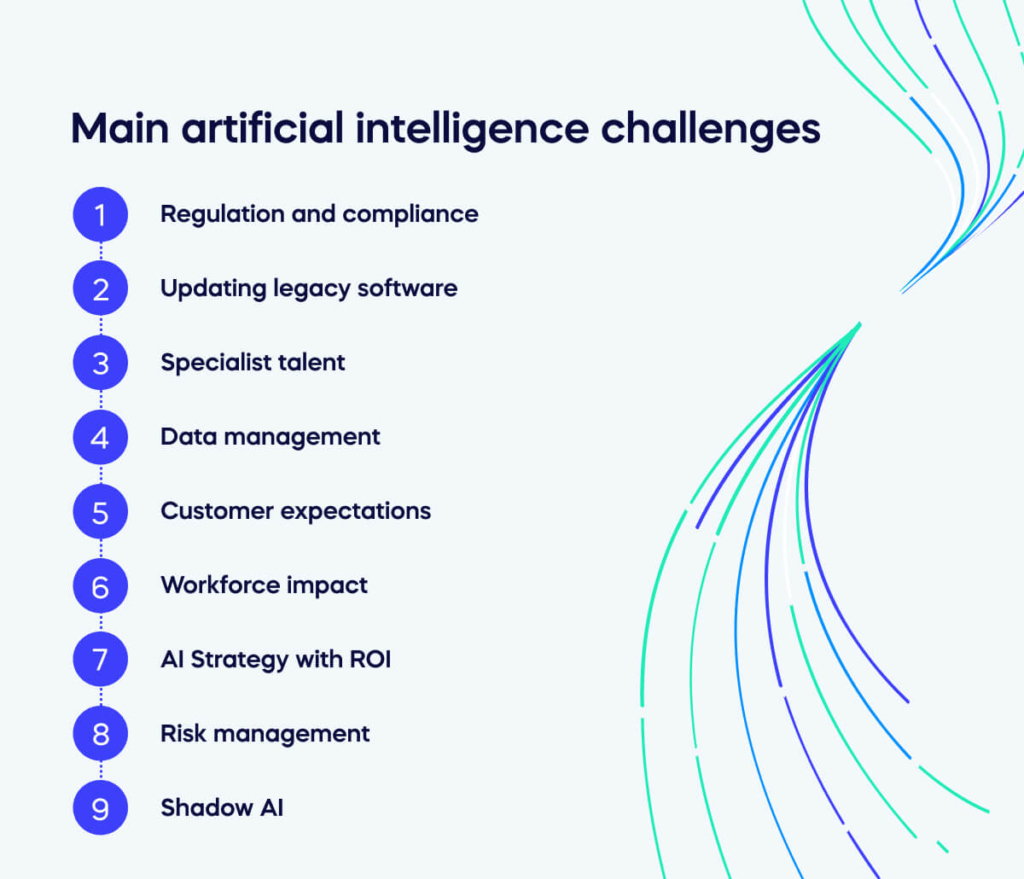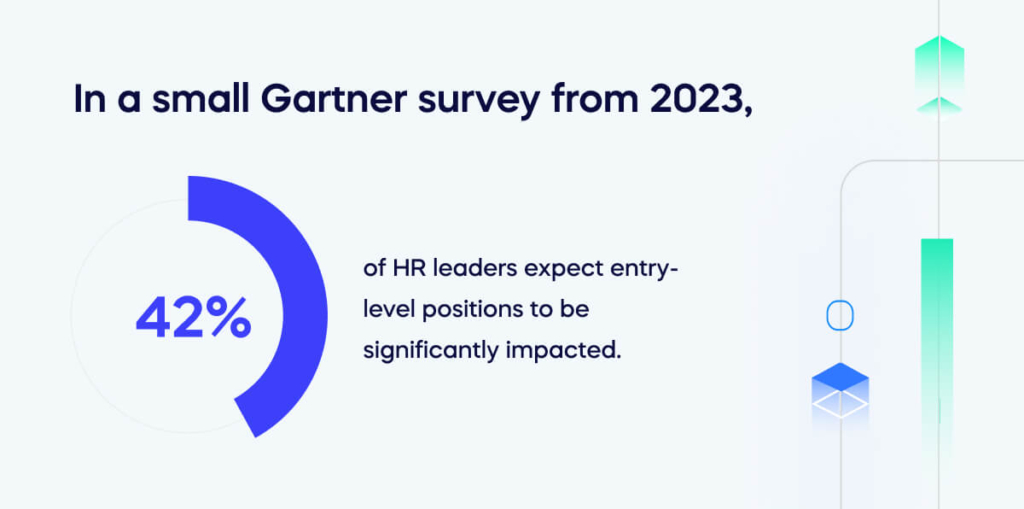Companies leveraging technology to enhance their business success often encounter a set of prominent challenges in the realm of artificial intelligence.
Here are the top 8 hurdles faced by organizations venturing into the AI landscape:
- Regulation and compliance
- Updating legacy software
- Specialist talent
- Customer expectations
- Workforce impact
- AI Strategy with ROI
- Risk management
- Shadow AI.
These challenges are different from the general risks of AI, which could impact businesses and individuals alike. The AI challenges we’ll discuss today are stopping companies from making the most of the latest technology.
While AI-oriented companies’ valuations are sky-high, we must remember that implementing AI is difficult for many businesses.
In this article, we aim to bring you up to speed by addressing the challenges. We will dive into how we tackled these obstacles and subsequently explore each in detail.
We will also provide timely insights into best practices when effective solutions are available.
How we chose the top AI challenges
Let’s take a cross-sector view of AI challenges. Fortunately, several voices are now helping us understand how AI could play out over the coming months and years.
So, we’ve drawn on some of the most comprehensive research in business IT:
- KPMG’s Generative AI Survey from 2023
- Deloitte’s 2023 report on “The magic behind turning data into profit”
- McKinsey’s “State of AI” report from 2023
- Statista’s survey on AI adoption barriers.
AI systems are still very new technology. So, we must listen to the most expert advice in digital adoption and management. No one can predict the future, but IT experts in IT systems can show us how current plans could become a reality.
The opportunities and challenges for AI are different in every sector: in sales, insurance, finance, and more.
Let’s dive into our main artificial intelligence challenges.

Regulation and compliance
Regulation and compliance remain critical AI challenges in 2023 due to the rapid advancement and widespread adoption of artificial intelligence technologies.
As AI systems become increasingly integrated into various sectors, concerns regarding their ethical use, accountability, and potential algorithmic bias have intensified. Governments and organizations are grappling with the need to establish robust regulatory frameworks that ensure AI systems adhere to ethical standards and legal requirements.
Additionally, compliance with these regulations poses a significant challenge for businesses, as they must navigate complex and evolving rules to avoid legal liabilities and maintain public trust.
Balancing innovation and responsible AI deployment is paramount, making regulation and compliance central concerns in the AI landscape of 2023. Companies that already have systems of software compliance will be in a good position to adapt to the new systems.
Updating legacy software
Adapting existing systems to generative AI poses a substantial challenge in the current AI landscape due to the fundamental disparities between traditional software and AI-driven generative models. Legacy systems are typically built on fixed, rule-based architectures, while generative AI relies on neural networks and deep learning, which are dynamic and data-driven.
Integrating AI into these legacy systems requires a significant overhaul of their existing infrastructure and data pipelines and often requires major reengineering efforts. Moreover, legacy systems might lack the data quality and quantity needed for effective AI training, leading to data compatibility and reliability issues.
In the coming years, we will see robust infrastructure systems combining AI technologies with older applications. Right now, this can be a challenge for businesses getting started with their AI implementation.
Specialist talent
For years, HR professionals have complained about an IT talent shortage. The major AI developments of 2022 and 2023 have created some specific challenges.
The surge in AI projects and the integration of AI into various industries have intensified the demand for specialized AI talent. However, the supply of experts well-versed in the intricacies of artificial intelligence, machine learning, and data science has struggled to keep pace.
This scarcity of skilled professionals has become a pronounced AI challenge in 2023, hindering organizations’ ability to harness the full potential of AI technologies and drive innovation effectively.
Data management
For AI applications, the quality, accessibility, and comprehensiveness of data directly impact performance. That’s why data management and data visibility are key challenges for companies implementing AI initiatives for their business processes.
More specifically, ensuring that data is clean, well-structured, and representative of diverse populations is essential for training models that make accurate and unbiased predictions.
Maintaining transparency in data sources and processing is also crucial for addressing ethical concerns, regulatory compliance, and building trust in AI systems, which are increasingly integrated into various aspects of society.
It’s no news that a new software system needs good data to run effectively. But we’re still trying to get to grips with what that means for AI.
Customer expectations
Many business leaders are delighted by the possibilities of AI. But customers still don’t know quite what to make of it.
The insurance industry gives us a good example. For insurance, AI has the potential to radically increase the speed of quotes and claims. Surely this is a win-win situation for businesses and customers alike?
Unfortunately, it’s not quite as clear as that. A 2023 YouGov survey – commissioned by the insurtech company Sprout – found that “customer expectations are still unpredictable” when they encounter AI services. Among US and UK respondents, one-third would actively choose NOT to go with an insurer that used AI.
So when it comes to customers, there’s an extra job to do. Never mind the AI algorithms you’re using – you need to make your processes transparent, find ways to build trust, and make sure you educate customers about the benefits of AI.
Workforce impact
For many, the computing power of generative AI will not displace their jobs. However, we must consider the possibility of job displacement and transformation across various industries.
In a small Gartner survey from 2023, 42% of HR leaders expect entry-level positions to be significantly impacted.

Automation and AI technologies have the potential to streamline operations, increasing efficiency but also reducing the demand for certain routine tasks. Consequently, there is a pressing need for workforce upskilling and retraining to ensure that individuals can adapt to new roles that require uniquely human skills, such as creativity, critical thinking, and emotional intelligence.
Managing this transition effectively is crucial to mitigate the negative repercussions of AI-driven job changes and foster economic resilience in the face of automation.
AI Strategy with ROI
Designing an AI strategy that achieves a good return on investment (ROI) is challenging due to the intricate interplay of factors like data quality, model accuracy, infrastructure costs, and ongoing maintenance.
Determining the precise business use cases where AI can deliver tangible value, securing the necessary talent and resources, and navigating the evolving AI landscape require careful planning and continuous adaptation.
Moreover, the long-term benefits of AI often take time to materialize. That makes it imperative to balance short-term costs with the expectation of future gain.
Digital Adoption Solutions (like WalkMe) have been a core ingredient in digital adoption strategies for years.
Risk management
Risk management is a critical challenge when implementing AI in an organization because AI systems can introduce various forms of risk, including ethical, legal, and operational.
The potential for biases in AI algorithms, data breaches, regulatory non-compliance, and unexpected system behavior can lead to reputational damage and financial liabilities.
Organizations must establish robust governance frameworks, data management practices, and transparency mechanisms to mitigate these risks. Effectively managing these risks is essential for ensuring legal and ethical compliance, maintaining stakeholder trust, and successfully integrating AI into business operations.
Shadow AI
Shadow AI is a new problem.
Like its older cousin, Shadow IT, the “shadow” in Shadow AI refers to the unauthorized use of AI systems solutions for internal business solutions. It’s not surprising – many people can capture AI’s ability to solve problems. And most existing employees want to make their jobs as straightforward as possible.
However, Shadow AI can introduce many problems with compliance, risk, regulation, and more. Some companies will even completely ban shadow AI applications. It’s a good idea to take action before it becomes a major challenge.
AI technologies: opportunities and challenges
Many companies are captivated by the potential of generative AI. However, as emphasized in this article, they face significant obstacles in implementing AI systems and gaining a competitive edge.
Fortunately, the emerging AI industry offers numerous solutions. Nevertheless, these common challenges still require internal resolution.
Businesses are recognizing the hurdles associated with AI adoption. And with these tools comes the potential to unlock incredible transformative power across various sectors.


